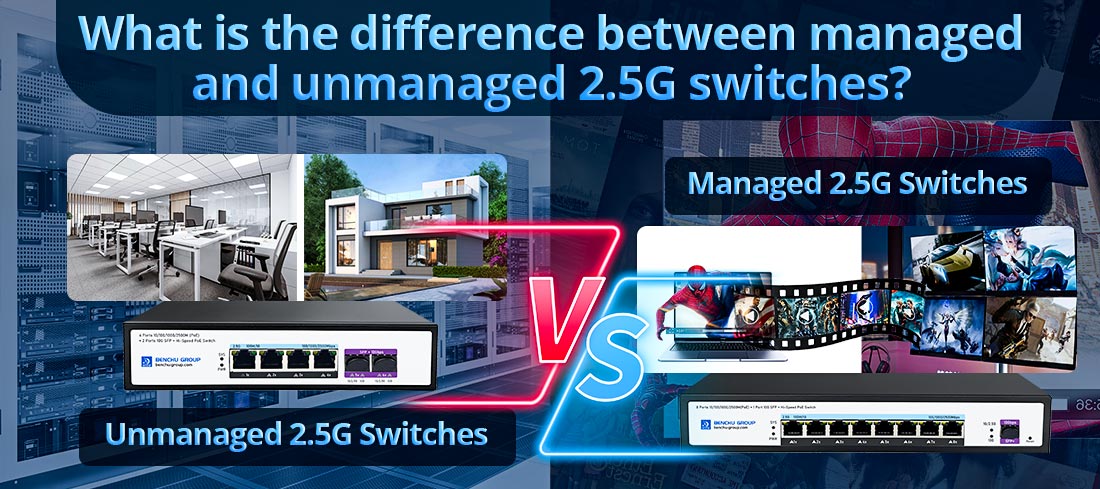
The distinction between managed and unmanaged 2.5G switches is crucial for understanding how to configure and manage a network effectively. Here’s a detailed breakdown of the differences between these two types of switches:
1. Basic Definitions
--- These are simple plug-and-play devices that do not require any configuration. They are typically used in smaller networks or less complex environments where basic connectivity is sufficient.
--- These switches offer advanced features that allow for greater control and customization of the network. They require configuration through a web interface, command-line interface (CLI), or dedicated software, enabling network administrators to optimize performance and security.
2. Features and Capabilities
Unmanaged 2.5G Switches
Ease of Use:
--- Plug-and-play setup with no need for configuration. Just connect devices, and they will communicate without additional setup.
Limited Functionality:
--- Basic connectivity with no options for traffic management, VLAN support, or network monitoring. They typically provide standard switching capabilities without advanced features.
Fixed Ports:
--- Generally, they come with a set number of ports (e.g., 5, 8, or 16) and do not allow for any modifications to port configurations or assignments.
Cost-Effective:
--- Typically less expensive than managed switches, making them suitable for small networks or budget-conscious installations.
No Network Monitoring:
--- Lack the ability to monitor network performance, diagnose issues, or log traffic data. Users may not be aware of network bottlenecks or device failures until they manifest as performance issues.
Managed 2.5G Switches
Configuration and Control:
--- Allow for extensive customization and configuration, enabling users to manage settings according to specific needs. This can include setting up IP addresses, configuring port settings, and more.
Advanced Features:
--- Support for VLANs (Virtual Local Area Networks), QoS (Quality of Service), link aggregation, and network security features such as port security and access control lists (ACLs). These features help optimize performance and enhance security.
Network Monitoring and Management:
--- Many managed switches offer SNMP (Simple Network Management Protocol) capabilities, allowing network administrators to monitor traffic, performance, and device status. This is essential for troubleshooting and maintaining network health.
Scalability:
--- Managed switches are generally more scalable, allowing for easier integration of new devices, expansion of the network, and support for more complex network architectures.
Cost:
--- Typically more expensive than unmanaged switches due to the advanced features and capabilities they provide. The investment is often justified in larger or more complex network environments.
3. Use Cases
When to Use Unmanaged 2.5G Switches
Small Networks: Ideal for home offices, small businesses, or basic network setups where simple connectivity is needed without extensive management.
Cost-Conscious Solutions: A good choice when budget constraints limit investment in advanced networking hardware.
Temporary or Limited Use: Suitable for temporary installations or situations where the network does not require ongoing management.
When to Use Managed 2.5G Switches
Larger Networks: Essential for medium to large enterprises that require advanced management and monitoring capabilities.
Complex Network Architectures: Necessary when deploying multiple VLANs, implementing QoS for critical applications (like VoIP or video streaming), or managing a mix of wired and wireless devices.
Network Security and Performance Monitoring: Critical for environments where security and performance are paramount, such as data centers or businesses with sensitive data.
4. Summary of Differences
| Feature | Unmanaged 2.5G Switch | Managed 2.5G Switch |
| Configuration | Plug-and-play | Fully configurable |
| Ease of Use | Simple setup | Requires setup and management |
| Advanced Features | Limited | VLANs, QoS, link aggregation, etc. |
| Network Monitoring | None | SNMP and performance monitoring |
| Cost | Lower cost | Higher cost |
| Use Cases | Small networks, home offices | Large networks, enterprise solutions |
Conclusion
In summary, the choice between a managed and unmanaged 2.5G switch depends on the specific needs of your network. Unmanaged switches are suitable for simple, budget-conscious setups, while managed switches offer the advanced features, control, and monitoring capabilities necessary for more complex environments. By understanding these differences, you can select the appropriate switch type to ensure optimal performance, security, and scalability for your network.